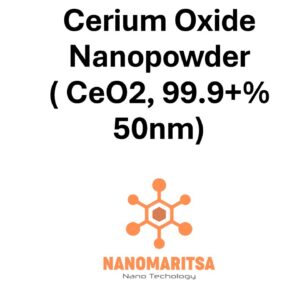Zirconium Oxide Nanopowder (ZrO2, high purity 99.95%, 20 nm)
€128.00
CompareZirconium oxide nanopowder (ZrO2) is a high-purity ceramic material with exceptional properties such as high mechanical strength, resistance to thermal expansion, and chemical stability. With a particle size of approximately 20 nanometers and a purity of 99.95%, this nanopowder is widely used in applications requiring high-performance materials, such as electronics, catalysis, and medical devices.
Composition and Structure
ZrO2 (Zirconium Oxide):
Zirconium oxide, also known as zirconia, is a white crystalline oxide of zirconium. It exists in multiple phases, including monoclinic, tetragonal, and cubic, with the tetragonal and cubic phases being the most stable at high temperatures. Zirconia is renowned for its high melting point (about 2700°C), high hardness, and excellent resistance to wear, corrosion, and thermal shock.
Purity (99.95%):
The high purity of 99.95% ensures minimal impurities in the nanopowder, which enhances its performance in advanced applications where material integrity and consistency are critical. This high purity is particularly valuable in sensitive fields such as biomedical applications, electronic components, and high-temperature industrial processes.
Particle Size (20 nm):
The 20 nm particle size provides a large surface area to volume ratio, which significantly enhances the reactivity and performance of zirconium oxide in various processes. Nanoparticles of this size exhibit unique properties, such as increased catalytic activity, improved dispersion in liquids and composites, and enhanced mechanical properties compared to bulk materials.
Properties
- Mechanical Strength and Durability:
Zirconium oxide nanopowder exhibits high mechanical strength, making it suitable for applications where wear resistance and structural integrity are crucial. It is commonly used in ceramics, coatings, and as a reinforcement material in composite structures. - Thermal Stability and Resistance to Thermal Shock:
Zirconium oxide is highly resistant to high temperatures, which allows it to maintain its structure and properties in extreme conditions. Its ability to withstand thermal shock makes it ideal for applications in high-temperature environments, such as in furnaces, engines, and other heat-sensitive devices. - Chemical Inertness and Corrosion Resistance:
Zirconium oxide is chemically inert and resistant to corrosion, which makes it suitable for use in harsh chemical environments. It is often used in chemical reactors, as a catalyst support, and in the manufacturing of corrosion-resistant materials. - Phase Stabilization:
Zirconium oxide is known for its ability to stabilize its tetragonal or cubic phases at room temperature when doped with certain stabilizers (e.g., yttria). This stability enhances its mechanical properties, making it more suitable for various high-performance applications.
Applications
1. Ceramics and Composites:
Structural Components:
Zirconium oxide nanopowder is used to produce high-strength ceramics for structural components in aerospace, automotive, and industrial applications. Its superior hardness and toughness make it ideal for cutting tools, wear-resistant coatings, and protective components in machines and engines.
Dental and Medical Ceramics:
Due to its biocompatibility and mechanical properties, zirconium oxide is widely used in dental implants, crowns, and bridges. The 20 nm nanopowder improves the aesthetic quality and strength of dental restorations. It is also used in medical devices, such as surgical tools, where high strength and resistance to corrosion are essential.
2. Catalysis and Chemical Processing:
Catalyst Supports:
Zirconium oxide nanopowder is used as a support material for catalysts in chemical reactions, especially in high-temperature processes like catalytic cracking and hydrocarbon reforming. The high surface area of the nanopowder increases the effectiveness of catalysts, improving reaction efficiency.
Fuel Cells:
In fuel cells, zirconium oxide serves as an electrolyte material, particularly in solid oxide fuel cells (SOFCs). Its ionic conductivity at high temperatures is key to the function of these cells, which are used for energy generation in various industries.
3. Thermal Barrier Coatings:
Zirconium oxide is commonly used in thermal barrier coatings (TBCs) in gas turbines, jet engines, and other high-temperature machinery. The nanopowder improves the thermal insulation properties of these coatings, helping to protect components from extreme heat and prolonging their lifespan.
4. Electronics and Optoelectronics:
Dielectric Materials:
Zirconium oxide’s high dielectric constant and low loss factor make it a suitable material for capacitors and other electronic components. Nanopowders with smaller particle sizes exhibit enhanced properties, making them ideal for advanced electronic applications.
Optical Coatings:
Zirconium oxide is used in optical coatings for lenses and mirrors, where its high refractive index and optical transparency in the ultraviolet to infrared spectrum provide superior performance.
5. Biomedical and Healthcare:
Implants and Prosthetics:
Due to its biocompatibility, high strength, and resistance to corrosion, zirconium oxide nanopowder is used in the production of implants and prosthetics, especially in orthopedic and dental fields. The 20 nm particle size helps achieve smooth surfaces and high-quality finishes for implants.
Diagnostic Devices:
Zirconium oxide is also used in diagnostic tools due to its stable and reliable performance in various chemical and physical tests, particularly in high-temperature applications in medical research.
Safety and Handling
Health Considerations:
Zirconium oxide is generally considered safe, but like many nanopowders, it should be handled with care to avoid inhalation or direct contact. Protective measures, including gloves, masks, and proper ventilation, are recommended during handling and processing.
Environmental Impact:
Zirconium oxide is chemically inert and not known to pose significant environmental risks. However, as with any nanopowder, precautions should be taken to prevent widespread dispersion in the environment.
Summary
Zirconium oxide nanopowder (ZrO2, high purity 99.95%, 20 nm) is a highly versatile material with exceptional mechanical, thermal, and chemical properties. Its high purity and nanoparticle size make it ideal for a wide range of applications, including advanced ceramics, catalysis, thermal barrier coatings, and medical devices. Its combination of strength, durability, and stability under extreme conditions ensures its continued importance in various industrial, scientific, and technological fields.
| Measurement (gr) | 100 grams, 500 grams, 1000 grams |
|---|






